
Port-mobile unloader sets new standards
13 Aug 2019Are you looking for a highly agile, extremely efficient, port-mobile system that can champion the performance of a pneumatic unloader? If you are, here are six reasons why Bruks Siwertell’s new port-mobile unloader might be just what you are looking for
Investing in any new technology is a major decision. Most importantly, bulk handling equipment owners want it to meet their operational needs; they, as in any other business, want maximum return on investment, the highest efficiency, and the lowest running and maintenance costs. They also want to know that their choice of investment presents the very best of what the market can offer. Every new investment should be scrutinized against these expectations, but not every new technology will deliver them.
Margins are tight, especially for grain-handling operators having to respond to variable import quantities, or for those whose import volumes do not justify the economies of scale delivered by large, fixed unloading installations. For this reason, Bruks Siwertell has developed the port-mobile unloader. Available in two sizes, a 400t/h and a 600t/h version, the unloader range serves vessels up to 60,000 dwt. Here are six good reasons why operators should be considering them.

Reason 1: outstanding flexibility
The new port-mobile unloader offers unmatched flexibility and has been optimized for use in ports. The weight and dimensions of its steel chassis has been minimized so that it has a lightweight and small footprint, ensuring that it takes up as little precious space on the working quay as possible or when it is stowed between jobs.
It is equipped with a self-propelled rubber-tyre system and an advanced steering solution for full, easy maneuvrability between operations. Its movements are operated manually or by using any of the pre-programmed driving modes and can travel straight ahead, in reverse or diagonally, both to the left and to the right. It is also able to smoothly rotate up to 30 degrees both left and right.
When stationary, the end pairs of axles, both on the sea-facing and land-facing sides, are turned by 90 degrees to secure the gantry in all directions when parked. During operations, the port-mobile unloader is supported by hydraulic jacks for increased stability.

The port-mobile unloader inherits benefits common to all Siwertell screw-type unloaders. One of these is the flexibility to handle many different types of cargo with a single machine, and without modification.
As a result, the port-mobile unloader is not limited in the types of cargo to be handled. Unlike pneumatic systems, which are only suitable for fine grains, Siwertell machines can gently and efficiently handle all manner of grains as well as larger soya beans and feedstuffs.
Reason 2: impressive efficiency and environmental protection
High through-ship efficiency and therefore fast port-turnarounds was a key development driver for the port-mobile unloader. The result, the through-ship efficiency of a port-mobile unloader is better than that of a pneumatic system. In part, this is ensured by how the unloader operates within a ship’s hold.
Unlike a pneumatic unloader, which can only operate its intake nozzle in a vertical direction, the Siwertell port-mobile unloader can move its vertical arm +/- 30 degrees and reach all areas of the cargo hold, including the troublesome area underneath the hatch corners. This maximizes efficiency rates and minimizes any cargo left for the payloader at the end of the unloading operation, ultimately improving through-ship speed.
Even where the finest grains are concerned, the port-mobile unloader offers the best environmental protection on the market. It has a totally-enclosed conveying line to eliminate dust emissions and as its vertical intake nozzle is submerged in the cargo, dust creation from cargo avalanches is completely avoided.
The port-mobile unloader is also extremely efficient to run. It uses the latest diesel engine specifications and these also meet the strictest environmental regulations on exhaust and noise emissions.
Reason 3: unbroken cargo flows
Any interruption to the flow of material negatively impacts efficiency. Therefore, to minimize the impact of truck changeovers or an irregular truck supply, the unloader is equipped with a large-volume intermediate surge hopper. This hopper allows for discharge operations from a ship to continue even if no trucks are available immediately.
A dual truck-loading system, with the option for a third loading system, keeps the unloader working as continuously as possible during truck loading, operating independently of one another to deliver the fastest loading operation possible.
Also designed to minimize any cargo flow interruptions, a separate fuel tank, including an automatic fuel-replenishment system, is incorporated into the unloader.

Reason 4: profits from gentle handling
One of the greatest advantages of unloading grain with screw-conveyor technology is the low degradation rates of the material. A low conveying velocity and a gap between the screw and the casing prevents the kernels becoming crushed during unloading.
Siwertell unloaders therefore avoid the cargo degradation concerns that traditionally accompany the high-conveying velocities of pneumatic unloaders, but maintain equivalent throughputs.
Cargo degradation is a concern for many commodities, but within grain handling it can really impact profits. If not handled gently, grain cargo breaks-down, this causes the production of fines, which are powdery particles. These fines can pose some significant financial and safety concerns.
They can mean that the whole grain shipment is downgraded as fines make it more difficult to aerate the grain, which increases spoilage rates. They also have to be removed before milling; therefore their presence has a significant knock-on effect on grain processing as a whole. Furthermore, the greater the number of fines produced, the greater the dust emissions, raising the risk of fire and explosion in storage silos and other confined areas.
Siwertell’s claims for extremely low material degradation rates have been independently validated many times over decades, both by Siwertell customers and by third-party inspectors, using comprehensive testing regimes and measurements before and after unloading.
Reason 5: lowest total cost of ownership
The port-mobile unloader offers an extremely competitive total cost of ownership. From the outset, it has a very lightweight design, which avoids any costly infrastructure or preparatory quay-reinforcement work.
In terms of operational costs, these, in part, depend on total unloading times and therefore it is important to maintain high average through-ship capacities. This also reduces any demurrage costs. The port-mobile unloader achieves these high through-ship capacities with its continuous material handling rates and superior reach into a ship’s holds.
The new port-mobile unloader shares the tried-and-tested technology of other Siwertell grain-handling units and uses simplified, standardized technology, which keeps maintenance and wear parts costs relatively low compared with other unloading systems on the market.
Its robust, simple mechanics also translate into very low maintenance costs, especially in comparison to the high-intensity demands placed on a pneumatic system’s key components. This is because the continuous low-velocity motion of the counter-rotating screw places little strain on working components. Unplanned downtime is brought to a minimum, and predictable forces within the unloader make it possible to accurately plan for maintenance intervals and the timely replacement of wear parts.
Reason 6: exceptional support
The fundamental aim of Bruks Siwertell’s service work is to ensure that its customers have a safe, efficient dry bulk handling system that they can rely on, but key to this service is the bridge that Siwertell builds with its customers, dedicating a specific member of staff for each and every customer. It believes that this, along with good teamwork, assures its customers that they can rely on Siwertell.
These dedicated connections are backed-up by expertise and resources. Experienced personnel, with excellent technological knowledge, are behind its commitment to customer care. This experience delivers many benefits to a customer. For example, during a service or inspection, a surveyor can rapidly assess a system and quickly determine its condition. It also means that Siwertell is often able to assist with temporary repairs, which can keep a machine up and running until new spare parts arrive.
Bruks Siwertell’s lifetime customer commitment is delivered through a global service network offering on-demand and emergency support and planned service agreements. Bruks Siwertell believes that customers should not only benefit from the advantages that their Siwertell unit offers today, but continue to do so in the years to come.
It is possible to try out a virtual reality environment for the port-mobile unloader and see how these capabilities could deliver significant benefits to your grain-handling operations. If any of the above reasons have made you curious, then why not get in touch?
PLEASE CONTACT US FOR MORE INFORMATION

Categories: Bulk unloading
 Bruks-Siwertell
Bruks-Siwertell